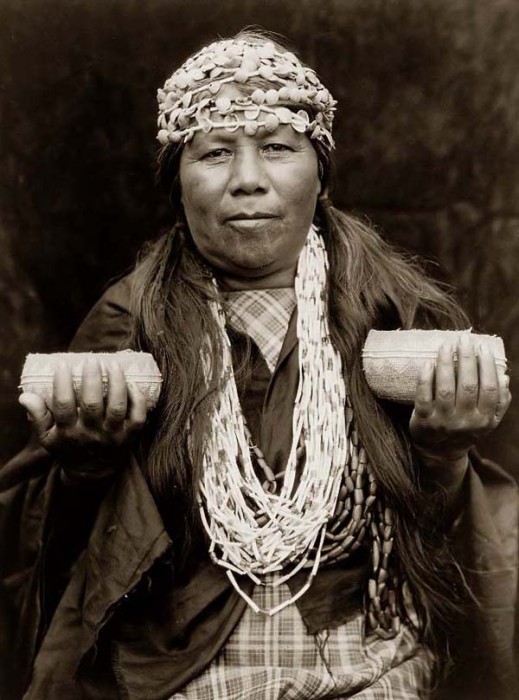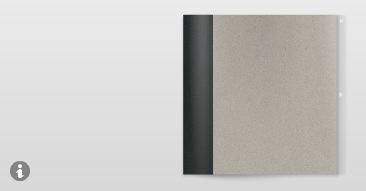Miloš Šejn | Českých Bratří 312 | CZ-50601 Jičín | T +420 723 701 658 | milos [at-sign] sejn.cz
7. 6. - 29. 9. 2025 | Gallery of Art in Litoměřice, Church of the Annunciation of the Virgin Mary
curator: Alena Beránková
6. 5. - 22. 6. 2025 | ATELIÉR JOSEFA SUDKA, Praha
curator: Petr Vaňous
ZATVÁŘÍ / COUNTENANCE
These are not only phenomena associated with the complex perception of place and time on their most general and essential levels. Often, it is also an exploration of incidental relationships that are hidden, obscured, or layered over time, relating to human memory, personal history, factual events, and mémoire involontaire. A particular phenomenon of this kind is the family memory of the sculptor Hana Wichterlová (1903–1990), who maintained a studio in Újezd, not far from Josef Sudek's studio, and whom Miloš Šejn knew personally as a child.
The exhibition layout for the Josef Sudek Studio creates an intersection of place, time, memory, and
media traces (photographs, videos, drawings). Sudek's photograph of Wichterlová's sculpture, entitled Black Head, plays a significant role here. Her closed eyes serve as the trigger for events, with inner vision as their main referent — the vision that connects the hiddenness of thought with the face of what is seen. Whether it be a human face, a face encountered as a metaphor for a place, a window, or a view. This theme is also reflected in the title of the exhibition, COUNTENANCE / ZATVÁŘÍ. The Czech neologism precisely captures the territory where any fleeting experience transforms into a timeless, lasting essence — an essence that does not disappear by being forgotten but, once formulated, continues to exist forever within a different order of validity.
10. 12. 2024 – 16. 3. 2025 | Galerie Rohovka – Vzlet, Praha
kurátor: Miloš Vojtěchovský
VZLET
Vyvolané obrazy
Presented by: Sylva Poláková
Guests: Miloš Šejn, Petr Vaňous
The screening will take place with the personal participation of the author Miloš Šejn and in the presence of the curator of the exhibition Petr Vaňous. The event takes place in cooperation with the gallery Jilská 14 (Memory deposit, 6 March - 27 April 2024).
https://nfa.cz/cs/39096-depozit-pameti-video-prace-milose-sejna-z-let-1988-2022?screening=39097
https://www.filmovyprehled.cz/cs/revue/detail/podilet-se-na-pretvareni
23. 10. - 23. 11. 2025 | Gong DOV Ostrava
23. 10. - 30. 11. 2025 | Rabasova galerie Rakovník - Nová síň pod Vysokou bránou, Vysoká 226, Rakovník
10. 9. - 28. 10. 2025 | Church of St. Nicholas and St. Anne, Telce
curator: Jaroslav Anděl
There are places that seem to hold a secret power over us—places that enchant, that draw us in. They are places of depth, where one may discover oneself, yet just as easily become lost. Often, these are realms governed by the elements: water, fire, earth, and air—sometimes singly, sometimes in pairs, sometimes in triads. They are sites that stir the imagination, that invite reverie, where one perceives the living web of connection between all things. Dreamers are those with the sensitivity to recognize such places, to enter into their depths. And though each of us carries within a fragment of the dreamer, and though almost any place may become a place of reverie, it seems that certain sites are, by their very nature, destined for it.
Some artists belong to this lineage of dreamers, drawn to particular places and elements, as the French philosopher Gaston Bachelard once so piercingly described. Lenka Falušiová is such a dreamer of the forest, which has remained for her a primal source of inspiration, encoded since childhood in the Jeseníky mountains. For her, the forest is an image of the living, breathing world—one in which human, animal, and plant exist side by side, on the same plane. The tree, that ancient cosmological symbol, rises again and again in her works. “Trees are the guardians of the forest,” she says. Yet Lenka is not a Bachelardian dreamer of any one of the four elements; she is, rather, a dreamer of light. If Bachelard turned to the verses of great poets to reveal the imagination of the elements, Lenka’s works may serve as a path toward the phenomenology of light itself.
Miloš Šejn, by contrast, is a dreamer of the earth. His place of initiation is Zebín, a volcanic hill near Jičín, where he has lived since youth. Zebín shaped his first painterly gestures and guided his further artistic journey toward ever more direct forms of contact with chosen sites—whether in the form of imprints of terrain, the gathering and testing of natural pigments, or performative acts of intervention. And although over the decades Miloš has engaged with other elements—water among them—it seems to me that his imagination feeds most deeply on the forces of the earth. Thus, as I linger over his works, the word chthonic comes insistently to mind. From the Greek chthōn, earth, it names what belongs to the soil, the subterranean, the underworld.
The work Delimitation of Space with Fire (1982) brings together two archetypal images of humankind’s earliest imaginings: fire and the cave. Here, fire recalls not only our primeval intimacy with flame but also the cataclysmic history of the earth itself, bound to volcanic upheaval. Šejn’s cave is a chamber of reverie, opening into the depths of human history as well as into the deep time of the earth.
Jaroslav Anděl
12. 9. - 12. 10. 2025 | GOMA Česká galerie moderního umění, Betlémské náměstí 8, Praha 1
Graphic Art of the Year is an exhibition project with a long-standing tradition and represents a unique event within the Czech Republic, dedicated to the presentation and dissemination of contemporary printmaking across a wide spectrum of Czech artists. Established in 1994, it takes the form of an annual nationwide competition and exhibition focused on current artistic production in the field of printmaking. Each year, the competition attracts hundreds of distinguished Czech artists as well as students. The exhibition serves as an important platform for fostering intergenerational artistic dialogue and provides both theorists and artists with the opportunity to evaluate current tendencies and developments in contemporary printmaking.
22. 11. 2025 | GASK Kutná Hora, Dalibor Chatrný 100 - konference
Forms of relationships between text and path/trace in space. The personal body and the body of the universe. Being and becoming. Place, places, non-places. Phonemes and eternity.
Performative lecture, approx. 15 minutes, combined with projection.
10. 9. 2025 | KAVKA, Praha
David Helán / Tomáš Ruller / Miloš Šejn
Conditions of Art / Performance Festival 31. 8. 2025
PRAGOVKA GALLERY
Kolbenova 923/34a, 190 00 Praha 9
28. - 30. 9. 2024 | Galerie Ferdinanda Baumanna, Praha
9. festival performance / Letná
9. festival performance / Veletržák
7. - 13. 7. 2024 Sloup, Sloupsko Šošůvské Caves, CZ
"We only talk to ourselves. We don't talk to the rivers, we don't listen to the wind and the stars. We interrupted a great conversation. By interrupting this conversation, we broke the universe. All the disasters that are happening now are the result of this spiritual 'autism'."
(Thomas Berry)
7° is an international art symposium situated in the environment of the Moravian Karst nature reserve. The name 7° symbolically comes from the temperature that is constant in the caves throughout the year (reported as 7-9°C). The purpose of the festival is to support interdisciplinary dialogue and develop artistic practice related to the themes of prehistoric art, karst caves, sustainable tourism, prehistoric architecture, natural sciences, anthropology, ecology.
The purpose of the festival is to support interdisciplinary dialogue and develop artistic practice related to the themes of prehistoric art, karst caves, sustainable tourism, prehistoric architecture, natural sciences, anthropology, ecology.
Participants in 2024
The jury led by Jana Písaříková and Ondřej Chrobák selected the following participants:
Olga Krása-Ryabets, Kryštof Krása, Lenka Pecharová (CAN, CZ)
Miloš Šejn (CZ)
Thomas Geiger (A)
Rudolf Sikora (SK)
Anna Jurkiewicz (PL)
Roman Zotov-Mikshin (CZ)
Dominik Forman (CZ)
Veronika Hudcová (CZ)
https://www.7festival.com/
20.06.2023 | knihkupectví ArtMap, Vojtěšská 196/18, Praha
03.09. 2021 – 07.09.2021 | Prague
curator: Helena Kontová, Jana Orlová, Elis Unique
The Prague Biennale Project 2021, a five-day festival of performance and video art, will take place from the 3rd to 7th of September in thirty locations across Prague. The fourth edition of the festival, subtitled Re-connect Art, will offer reflections on current topics including depersonalised communication, isolation, media ecology, and the relationship between humans and technology. Over fifty artists from around the world will present eleven live performances, five live streams, and over thirty videos. Mariánské náměstí will be the location for a gate that allows for two-way live streaming, connecting the artists and festival visitors directly. Entry to the festival is free of charge.
Prague, CZ
27.04.2019 | Národní galerie, Veletržní palác, Prague
“Theatrum Mundi” is a multimedia project that displays a model of the universe metaphorically as an endless circle of life where everyone is a co-creator and introduces art as a process that makes us what we are.
Theatrum Mundi III
22.09.2018 | GASK / Central Bohemian Gallery, Kutná Hora, CZ
Theatrum Mundi 2.0 will take place on Saturday September 22, 2018 from 15 am to 6 pm in GASK in Kutna Hora.
The following performances are: Lenka Klodová, František Kowolowsky, Gaby Bila-Gunther, Martin Zet, Jana Orlová, Kateřina Olivová, Marie Zandálková, © Merry, Jiří Surůvka, David Helan a Miloš Šejn, Johana Střížková, Petra Pětiletá, Markéta Garai, Ladislav Vondrák, Vladimír Havlík, Mira Gáberová, Mojmír Pukl, In sáček veritas, Jennifer Helia De Felice, Elis Unique, Markéta Ježová a Tereza Froncová, Katarina Kadijevic, Aneta Jaurisová, Filip Martínek, Mariana Kuželová, Tereza Sosíková, Jan Škrob, Helena Machová, Jan Běhounek
Concept author for Gask: Darina Alster
Curator Veronika Maresova
Sound: Anja Kaufmann
Installation: Michal Kindernay
Collaboration: Pavel Havrda
Acknowledgments: Studio Hrdinů
07.09.2018 | G HMP / Prague City Gallery
3-6 PM
Městská knihovna, 2. patro
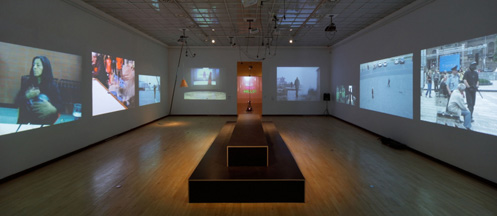
Perform-Made Event
Milos Sejn & David Helán
Agosto Foundation
Miloš Šejn will christen his new two-disk edition of Obraz-tělo-zvuk/Image-Body-Sound, released by Guerilla Records on his 70th birthday. Included in the event will be the presentation of the new book Časopysk by David Helán, once a student of Šejn, who now also performs with him. In addition, ArtMap will bring us up to date on future creative encounters and performative dialogue.
Miloš Šejn works in the fields of visual art, performance and study of visual perception, and conducts workshops, such as Bohemiae Rosa. His artistic concept was formed in his youth when he undertook many trips into the wilderness as a reflection of an inner need to get closer to the secret of nature and observe the miracles that happen in it. From the beginning of the 1960s he took pictures, drew, collected and described his observations of nature during these wanderings. Currently he teaches privately mixed media and the relationship of nature and art as intrinsic needs of the mind, and focuses on immediate creative possibilities, based upon relations between historical humanised landscapes and intact nature. He consciously is working in the areas of expressive language among text, visual stroke, body movement, voice, and expansion into space.
The CD contains various field recordings, such as the “ambient symphony” Colorum Naturae Varietas, while the DVD includes 27 recordings of a wide range, including performances, documentary works, video art, dream visions, drawings, images of nature, and the like. Included is a comprehensive interview, which in shortened form, appeared in the Revolver Review no. 103/2016. In all, the collection comprises an unusual, uncensored probe into the soul of the versatile artist, who in his work goes “beyond the limits”.
David Helán takes up the conceptual tendencies of the latter half of the 20th century. His works are scattered broadly, including performance, video performance, action art, installation, photographic works, fine art and new media, and their fusion. His name is also linked with the artist David Hřivňacký, with whom he has staged various performances mostly in gallery spaces. It is a characteristic of Helán and Hřivňacký’s works to use dadaistic principles, spontaneous immediacy, experimentation and humor. Last year, the dual-language author’s dictionary titled Časopysk won the call at the annual pilot project Artist Book #1 v Meet Factory.
Organized by: ArtMap Book Store, Agosto Foundation, Guerilla Records.
The event will take place at the Prague ArtMap bookstore in Vojtěšská 18 on Monday 27th November from 18:00.
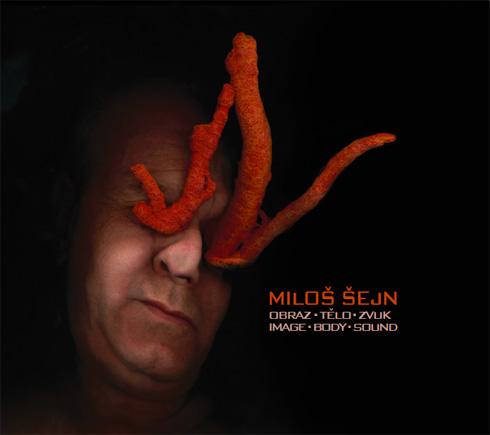 Of his bones are Corrall made: Those are pearles that were his eyes... ARIELL SONG FROM THE TEMPEST BY W. SHAKESPEARE
Of his bones are Corrall made: Those are pearles that were his eyes... ARIELL SONG FROM THE TEMPEST BY W. SHAKESPEARE24.05.2017 – 27.05.2017 | Theatre Academy Helsinki
Organizers: Jay Mar Albaos, Antonín Brinda, Harriet v. Froreich, Petros
Konnaris, Jolijn de Wolf / MA Degree Programme in Live Art and
Performance Studies (LAPS), Theatre Academy of the University of the
Arts Helsinki
Bubbles are not
kindly regarded in these days.
They are associated with many of our current world's issues: social
injustice, a lack of solidarity, rising prices, polluted water...
Our world bubbles, the earth is a bubble, and
we are in crisis. However, there is the aesthetic and life-preserving
potential of the bubble: it is an equally rich metaphor for isolation
and ignorance as it is for nurturance, safety and protection, and evenwwww.lapsody2017.com
more so for perfection and effervescence. A multitude of bubbles might
merge, expand, form a foam, or collide, burst and disappear.
For this year’s LAPSody, we invite experts and contributors from all
field to join The Bubble. Come explore the political, social,
environmental, philosophical, scientific and performative potential of
the bubble as a discursive and physical phenomenon.
We especially welcome proposals featuring non-conventional forms of
presentation, and are happy to facilitate these, for example lecture
installations, post-truth performances, site specific discussions,
phlegmatic workshops and one-on-one-situations.
LAPSody festival & conference will be taking place in the Theatre
Academy Helsinki as well at different outdoor and indoor sites around
the city of Helsinki. Other venues of LAPSody are currently being
negotiated and will be announced in the beginning of the year 2017.
wwww.lapsody2017.com
04.12. 2016 | KONVIKT / PAF Festival of Film Animation Olomouc
Darina Alster, Viktor Fuček, Mira Gáberová, Vladimír Havlík, David Helán, Lenka Klodová, Petr Krátký, Miloš Šejn, Viktor Takáč, Jan Valík, Vladimíra Večeřová, Martin Zet
http://www.pifpaf.cz/for-me-it-s-too-random
FoR mE iT’S tOO RAndOm is an allegory of performance. It represents an effort in pure beauty, while doing away with personal ballast and dissolving the ego – one of the most independent and carefully constructed personal components of the majority of artists-performers. Part of this event will be the Festival’s closing ceremony and the handing over awards in the jubilee tenth year of the Other Visions section.
The former Jesuit College is the location of the Art Centre of Palacký University. Lecture halls, workrooms and conference halls are located in this spatial baroque complex which consists of five art departments from the Faculty of Arts and the Faculty of Education. The Art Centre is involved in everyday cultural and artistic life. Inhabitants of Olomouc as well as tourists see film and theatre performances and concerts in the Corpus Christi Chapel and exhibitions installed in the large corridors.
Konvikt is accessible from Denisova Street. If you travel by tram, the Náměstí Republiky stop is not far away.
25.11. 2016 | PechaKucha Night Olomouc, Jungmannova 3, Olomouc
David Helán / Milos Sejn
04.11. 2016 | Art Space NOV, Pernštýnské náměstí 49, Pardubice, Czech Republic
Ján Valík / David Helán / Milos Sejn
NOV art space
22.06. 2016 BODY PERFOINTROMENT / 17. – 26.06.2016 | DRAK Theatre, Hradec Kralové, Czech Republic
Day Six
Wednesday 22nd June – PERFORMANCE/How Performance Artists See Theatre
Early radical performance pieces from the 60s excluded typical theatrical elements such as duality of theatre, actors, roles, plots, rehearsals and repetitions, stage, given temporal frame, but even sufficed without the audience. Is there still a difference between theatre and performance art today? Distinguished Czech performers will answer.
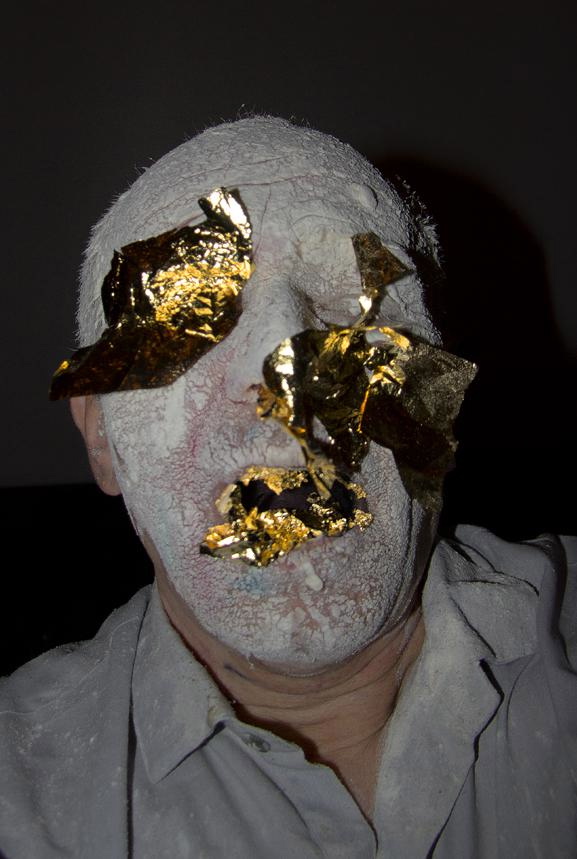
Festival
28.09.2015 | LUNA
In September 28 I am going to link my face with the face of the Moon telepathically. The intervention will be held 1 hour around the maximum of the Full Moon at 4:50 AM CEST (2:50 UT), ie 4:20 to 5:20 AM CEST (2:20 to 3:20 UT).
Part of the exhibition TIME 20 BK.
In Greek mythology, Selene (Greek Σελήνη) is the goddess of the moon. She is the daughter of the Titans Hyperion and Theia, and sister of the sun-god Helios, and Eos, goddess of the dawn. She drives her moon chariot across the heavens. Several lovers are attributed to her in various myths, including Zeus, Pan, and the mortal Endymion. In classical times, Selene was often identified with Artemis, much as her brother, Helios, was identified with Apollo. Both Selene and Artemis were also associated with Hecate, and all three were regarded as lunar goddesses, although only Selene was regarded as the personification of the moon itself. Her Roman equivalent is Luna.
The etymology of Selene is uncertain, but if the name is of Greek origin, it is likely connected to the word selas (σέλας), meaning "light".
Just as Helios, from his identification with Apollo, is called Phoebus ("bright"), Selene, from her identification with Artemis, is also commonly referred to by the epithet Phoebe (feminine form). The original Phoebe of Greek mythology is Selene's aunt, the Titaness mother of Leto and Asteria, and grandmother of Apollo, Artemis, and Hecate. Also from Artemis, Selene was sometimes called "Cynthia".
Selene was also called Mene. The word men (feminine mene), meant the moon, and the lunar month. It was also the name of the Phrygian moon-god Men.
WIKIPEDIA
This intervention was carried out as a part of the exhibition Before, Now, Afterwards | 20.9. – 20.10.2015
BLUDNY KAMEN
23.09.2015 | Kino AERO, Biskupcova 31, Prague 3, Czech Republic
8.20 PM
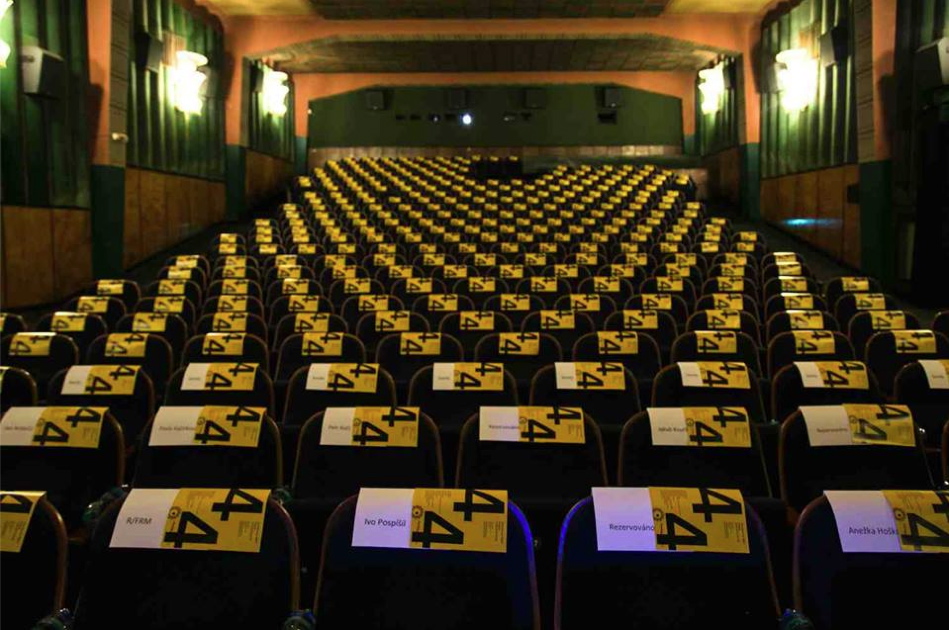
www.pechakucha.cz
www.kinoaero.cz
27.06. – 15.09.2015 | STATUES GIVEN THE GARDEN V, Kroměříž, Czech Republic
David Helán & Milos Šein
Chateau garden / The Long Pond, Saturday, June 27, 2015, 4:30 P.M.
GET ART
Chateau garden
18.04. 2015 | SOLAR MOUNTAINS
SOLAR MOUNTAINS
Day dreams in elemental landscape / Thora Solveig Bergsteinsdottir, Liv Nome, Miloš Šejn
A part of AENIGMA exhibition
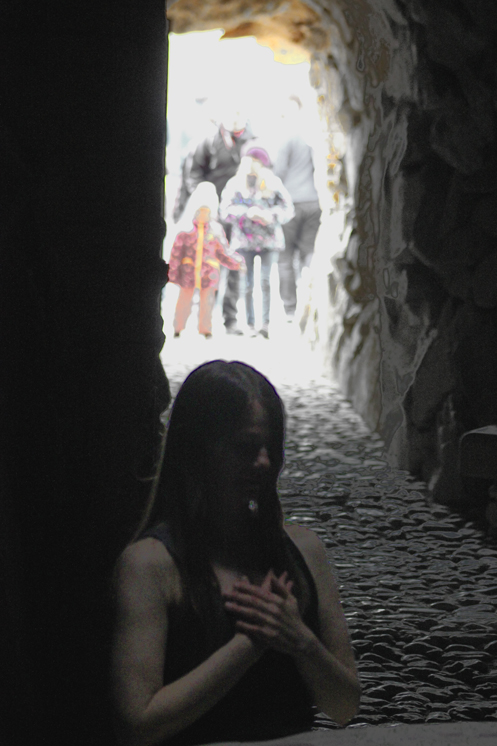

day of dreames
AENIGMA
Theatre festival ON THE EDGE
Friday, the 10th 4th 2015 - 18:00
Gentle provocation of Genius Loci by Day and by Night (with the participation of Milos Šejn and students of Theater production in non-traditional spaces from Academy of Performing Arts in Prague)
Plasy Monastery, Czech Republic
ON THE EDGE
26.06. – 27.06.2014 | LUHOvaný Vincent, Luhacovice Spa, Czech Republic
David Helán & Milos Šein
LUHOvany Vincent
11.08.2013 | B U D E Č 2013 třetí ročník mezioborového setkání v kulturní krajině
David Helán & Milos Šein
Hillfort Budeč, Sunday, the 11th August 2013, 3 P.M.
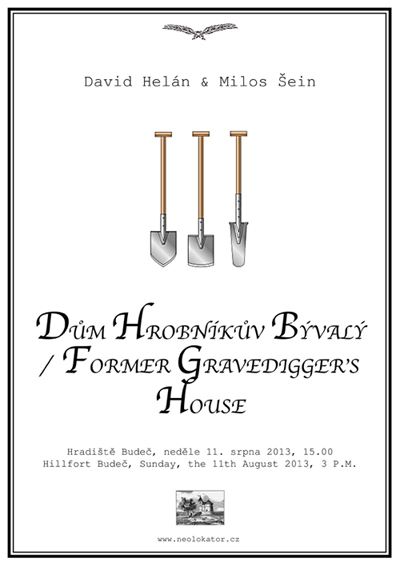
www.neolokator.cz
09.05.2012 | TAJGA BEZDÉZSKAJA
Katedra environmentálních studií FSS MU, Brno
Archeologický ústav AV ČR, Praha, v. v. i., Botanický ústav AV ČR, v. v. i., Filmová a televizní fakulta AMU v Praze, Vysoká škola uměleckoprůmyslová v Praze
a Okrašlovací spolek při Katedře environmentálních studií na FSS MU v Brně
Vás zvou na vernisáž komorní výstavy fotografií, grafik a objektů Jana Daňhela, Petra Meduny, Petra Pokorného a Jiřího Sádla
dne 9. 5. 2012 v 18 hodin
na chodbě Katedry environmentálních studií FSS MU, Joštova 10, Brno.
Na vernisáži vystoupí Miloš Šejn & David Helán.
photo: Šimon Barnat
TAJGA BEZDEZSKAJA
28.01.2012 | Uppsala Art Museum
Performances as a part of opening ceremony - VISCERAL SPACE: Cassius Åkerlund, Johannes Bergmark, Lee Berwick, Joan Laage, Stuart Lynch, Irma Optimist, Sören Runolf, Miloš Šejn
Milos Sejn: The Written Face for SU-EN, performance as a part of opening ceremony - VISCERAL SPACE, January 28; white rose, colour pencils, chair, body, blood, voice, singing
"bílé plátky
růže plátky
white petals
and
rose petals
shining
shining
through my body
like bright stars
for
SU-EN
..."
This year SU-EN Butoh Company celebrates 20 years of artistic activities!
The company was founded in Tokyo in 1992, after SU-EN recieved her name from Tomoe Shizune & Hakutobo through the performance Kaze no Cho.
This will be manifested through an art exhibition at Uppsala Art Museum – Visceral Space. There will be several rooms that SU-EN and collaboration partners fill with installations based on some of the company´s major pieces and projects. Most welcome to the exhibition!
We also release a catalogue mapping the 20 years, designed by Gunnar H Stening. The catalogue is available for free and can be ordered by e-mail: info@suenbutohcompany.net
January 28 – March 11, Visceral Space - exhibition at Uppsala Art Museum
Installations based on previous works SLICE, Scrap Bodies, Blush, Chicken Life and more. Collaboration partners for the exhibition is Skrotcentralen i Uppsala AB, Gunnar H Stening, Rickard Sporrong, Lee Berwick, (UK) Junichi Kakizaki (Japan), Fredrik Olofsson and Lise-Lotte Norelius.
Live events during the exhibition period:
January 28, 12 pm – OPENING 0F EXHIBITION, 15:00 opening speech, 16:00 Scrap Event outside the Art Museum, crane trucks and welders
February 18, Body Art performance installation in the SLICE room, with SU-EN
February 29, lecture artist talk by SU-EN and improvisation with Marie Gavois & Gustav Franklin
March 11, END, Blush action painting event, with SU-EN Butoh Company, 3 dancers and Lise-Lotte Norelius
www.uppsala.se/konstmuseum
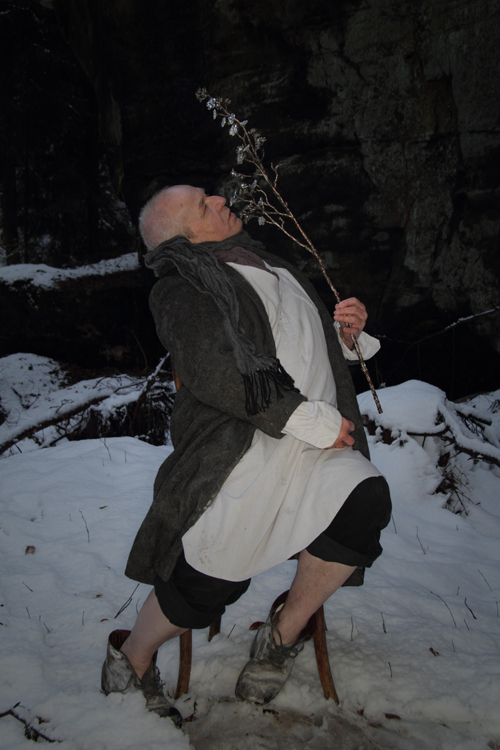
A study for The Written Face, January 20, 2012
28.10.2011 | Trafo Gallery, Prague
OFF INTERSECTION [Quadriennale of Unqualified]
curator: Linda Mikolášková
Performance by David Helán & Miloš Šejn
„Welcome note learned, pious and noble womens and mens, LIGHTS OF EUROPE!“
Performance, which is an adaptation of the project Czech Shed into the Trafo Gallery space, gives an entertaining and easily understandable form, many important findings, affecting all of us.
Panorthosia (Universal Reform) is the essential theme of John Amos Comenius's famous „General Consultation on an Improvement of All Things Human".
Obecná porada má:
1. Úvod, v němž se vykládá, co navrhujeme: nazývá se PANEGERSIA, to jest Kniha o všeobecném probuzení
- Vlastní soustavu, v níž se ke všeobecné nápravě navrhují
2. Základ, Všeobecné světlo: PANAUGIA, Dílčí počiny: totiž uspořádání
3. všech VĚCÍ, dotud naprosto neuspořádaných: PANSOFIA (Všeobecná moudrost)
4. všeho SMÝŠLENÍ, dotud naprosto zmateného: PAMPAEDIA (Vševýchova)
5. všech JAZYKŮ, dotud naprosto změtených: PANGLOTTIA (Všemluva)
6. Završení, PANORTHOSIA (Všenáprava)
7. Zavírku, obsahující porůznu opakované podněty k věcem tak žádoucím, k nimž vidíme tak jasně odkryté cesty. Bude nazvána PANNUTHESIA, Kniha o všeobecném povzbuzování.
(Obdobnou trojiční strukturu má pak opět každá ze sedmi knih.)
De rerum humanarum emendatione consultatio catholica, 1666
TRAFAČKA / TRAFO GALLERY
Kurta Konráda 1 (vchod z ulice Českomoravská) 190 00, Praha 9
Otevřeno: út-ne | 13:00-19:00
email: trafacka@trafacka.net
Spojení: tramvají č. 3 zastávka Ocelářská, nebo z metra Českomoravská 200 m.
http://offintersection.tumblr.com/
http://www.trafacka.net/cs/
http://www.amanitasproduction.cz
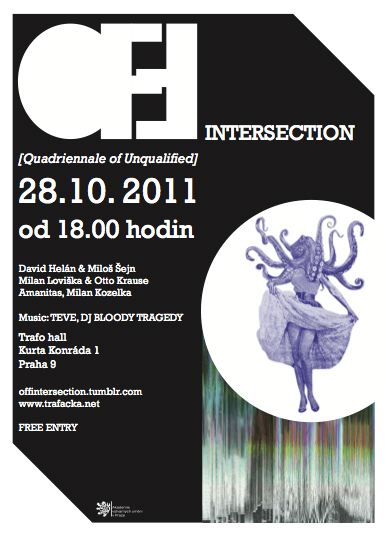
18.09. 2011 | Školská 28 / Communication space, Prague
A performance in Words and Movements by Milos Sejn and Frank van de Ven
Two moving and speaking bodies meander from an old shed to a courtyard and roof garden under some very low clouds. Their dialogue oscillates between past and future stories engendering translucent moments of understanding in the present.
SUN, SEPTEMBER 18, 2011, 19:30
www.skolska28.cz
22.08.2011 | The Holy Spirit Church / Liběchov, CZ
Our thirty-fifth the coral (canvas) wedding anniversary we celebrated by the one-hour awake death.
Realized in the burial crypt of the Church of the Holy Spirit in Liběchov.
curated by Jan Trejbal & Marek Přikryl
photo: Jakub Geltner
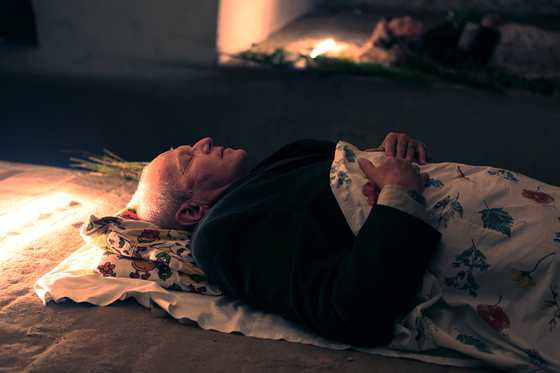
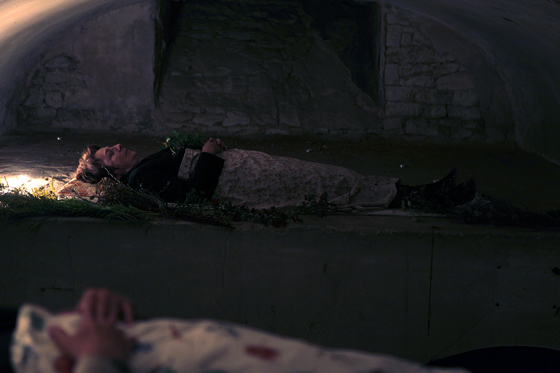
http://www.kaplelibechov.cz
Wedding anniversary
Libechov Olympus
20 June 2011 all day (00:01-23.59) | Prague
PQ+ / PRAGUE QUADRENNIAL OF PERFORMANCE DESIGN AND SPACE
PQ+ accompanying project of the Prague Quadrennial
The aim of the accompanying project of the 12th Prague Quadrennial, simply called PQ+, is to further develop PQ 2011’s interdisciplinary dialogue between various dramatic genres and an expanding definition of visual art.
HANDA GOTE // URBAN CAMPING
the Piazzetta of the National Theatre
A non-violent intervention in what remains of a public space
A 24-hour camping experience on the National Theatre’s piazzetta
The Handa Gote performance ensemble will spend 24 hours camping on the National Theatre’s piazzetta in homemade ceremonial masks and clothing. Relaxation, conversation, and games; a further unspecified ceremony; the erection of a portable temple for further unspecified godheads; cooking food and whiling the time away by playing on homemade instruments, through song and dance, the creation of arrowheads and other practical tools using available materials (glass from bottles, replacing the more difficult-to-find obsidian or flintstone), and a two- to three-hour ritual invocation of money.
The camp’s participation will in no way accost passers-by or onlookers. Their form of communication with be the radical absence of any outwards signs of belonging to majority society. These nomadic artistic homeless won’t have anything to be afraid of, either. They, too, know that it is normal to adapt. Inadaptability goes against the natural order and against culture itself.
Any gathering of people is legitimate, even if it has no aim of achieving a specific goal.
Prepared and performed by: Handa Gote research & development and guests
Tomáš Procházka / Robert Smolík / Pasi Mäkelä / Martin Janíček / Miloš Šejn / Jan Dörner / Jakub Hybler
production: jedefrau.org Cavina/Kalivodová
photo: Martin Vosáhlo
The artistic group Handa Gote research and development is a conceptual post-dramatic theatre ensemble working with audio installations, movement and dance theatre, live music, visual theatre, and technology. Its performances are characterized by a hidden poetics and a unique aesthetics, influenced by minimalism, eastern philosophy, the Do-It-Yourself movement, and the combination of old and new on both the technological as well as mental level. Handa Gote mixes Czech do-it-yourselfism, the reuse of objects and technologies, and inspiration from Japanese wabi-sabi aesthetics.
Four Days in the frame of Intersection – Prague Quadriennale of performance design and space 2011
OUT OF THE BOX - PROJECTS DESIGNED FOR THE PUBLIC SPACE
The art projects from the areas of theatre, dance, and the visual arts presented in this section work intensively with place, responding to the architecture, scenography, and design of public space. The selected artists address the subject of architecture and urbanism in a city where one can be an active participant, spatial catalyst, and true spectator of a new image of scenography. The selected projects present various different artistic approaches and ways of working with public space – site-specific projects, interventions, improvisation, performance art, or installations. The project’s main dramaturgical theme is playfulness, the tracing and exploration of the city’s iconography, and a shared interest in communicating about public space primarily with the city’s inhabitants.
Program coordinator Out of the Box
Projects for Public Space: Denisa Václavová
PQ+ / PRAGUE QUADRENNIAL OF PERFORMANCE DESIGN AND SPACE
Prague
http://www.pq.cz
melanchofobie
pq
International Performance Art Festival
10.06.2010 - 13.06.2010 | Uppsala konstmuseum, Uppsala, Sweden
Artists: Tomislav Antonio Gotovac, Vlasta Delimar, Ervin Babic, Ljubica Cvoric, Marina Tomic, Jason Lim, Boris Nieslony, Ko Siu Lan, Makoto Mauyama, Rakini Devi, Kate Pendry, Johanna Tukkanen, Nordic Dumpling, Hiroko Tsuchimoto, Fredrik Axwik, Linus Raudsepp, Milos Sejn, Aki Onda, Gracing Space Project
Works from Milos Sejn: Being Landscape / Dedicated to Carolus Linneus
Biz&Art
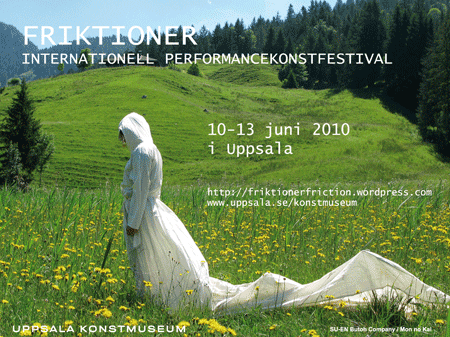
04.11. - 11.11.2000 | Holešovice brewery / Prague
Four + Four Days in Motion
5th International Theatre Festival
4th-11th November 2000
Holešovice brevery, Prague
organized by mamapapa, curator Tomáš Žižka, sound part Martin Janíček
Four + Four Days in Motion
S i t e B o d y E x p l o r a t i o n 26 - 31 August 2025
Lusatian and Zittau Mountains – The Czech Republic & Germany & Poland
International Interdisciplinary Open–Air Workshop for artists and dancers exploring the relation between body, art and landscape led by Frank van de Ven and Milos Sejn

16. 6. - 30. 9. 2025 | Kutná Hora - intervention in public space
curator: Petr Vaňous
14. – 15.12. 2024 | Centrum Plující oblaka, Mlýnská 6/3, Praha 6
A workshop for dancers and artists exploring the relation between body and art by Milos Sejn and Frank van de Ven
flyer
5. – 8. 12. 2024 | PAF – Festival of Film Animation and Contemporary Art, Olomouc
The 23rd edition of PAF Olomouc – Festival of Film Animation and Contemporary Art – will take place from December the 5th to the 8th, 2024. This year's festival theme is Diaries. Diaries can take the form of stories or notes, they can be a purposefully invested work in self-reflection, an unintended consequence of time spent on social networks, or any other form of periodic writing. But all these forms of recording raise the question – are diaries meant to be read?
Diaries take the form of narratives or notes that do not only relate to the calendar’s timeline. Diaries can also function with gaps and pauses in their records. Diaries are a dialogue with technology, where the transformation of thinking takes place based on the touch of keyboards, typewriters, recordings on a camera or a recorder.
Diary as a survival strategy. Diary for sharing. Diary as an emancipation tool. Diary as a manifestation. As a law of attraction. Diary as a memorial device. Diary as a marketing strategy. As a profession. As a source of income. As a promotion tool. Gossips. About you and others. Diary as a description. Of the weather, sport results, achievements, mood. Diary as a habit tracker. Diary for keeping history alive. Diary as an interpretation. Diary as therapy. Diary as telling the stories of others. Diary as telling your story.
Jan Bara / Qow & Theo Alexander Stepan Broz / Jeanie Crystal / DJ GÄP / Michelle Williams Gamaker / Julia Grybos / Honour / Andrea Pruchova Hruzova / Basim Magdy / Zein Majali / Olan Monk / Nicoleta Mures / Sylva Poláková / Emily Pope / George Finlay Ramsay / RRRR+A / Milos Sejn / Coby Sey / Marie Sprinc / Petr Sprinc / Medard Zeman / Barbora Zentkova / Isama Zing
PAF
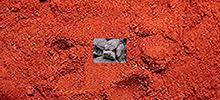



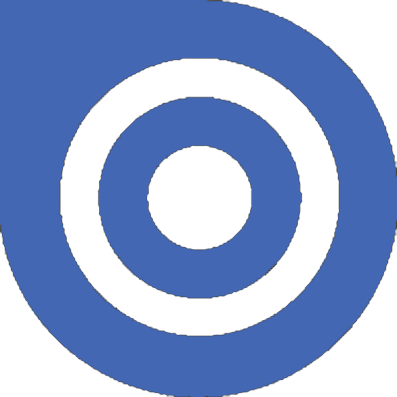
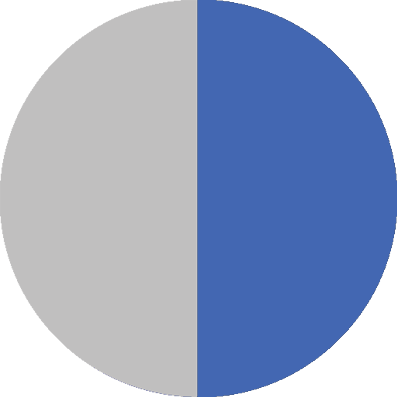
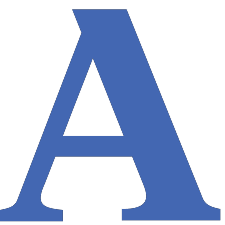

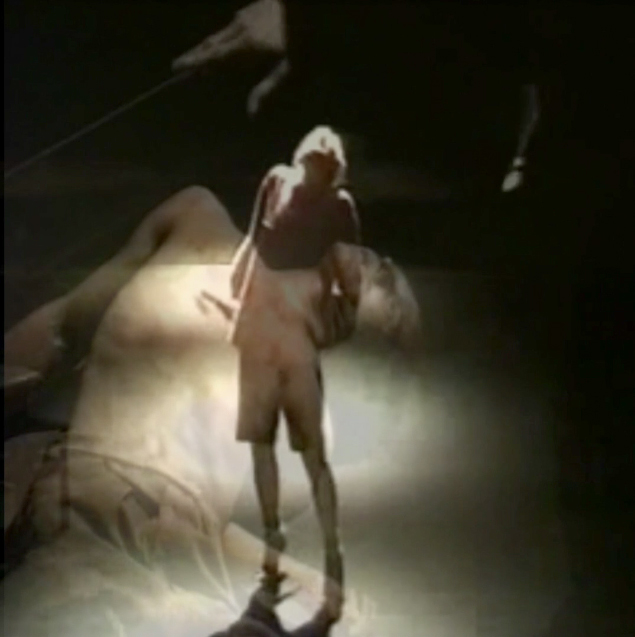
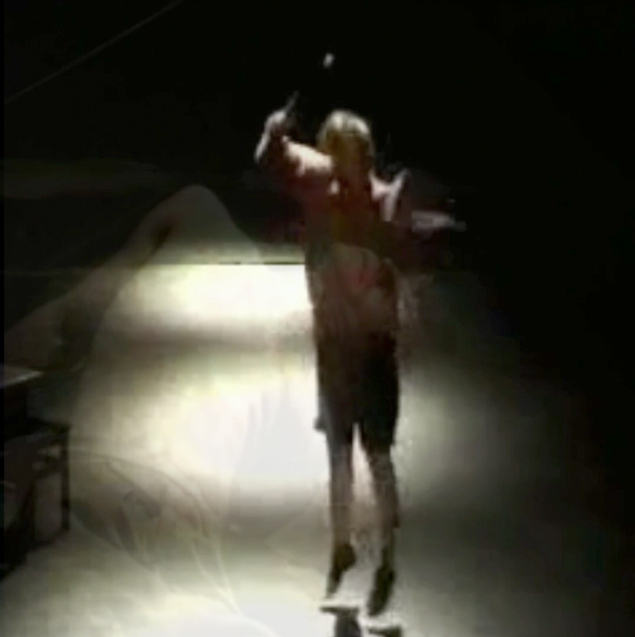
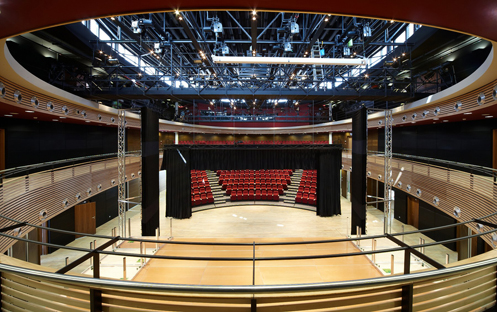
.jpg)

